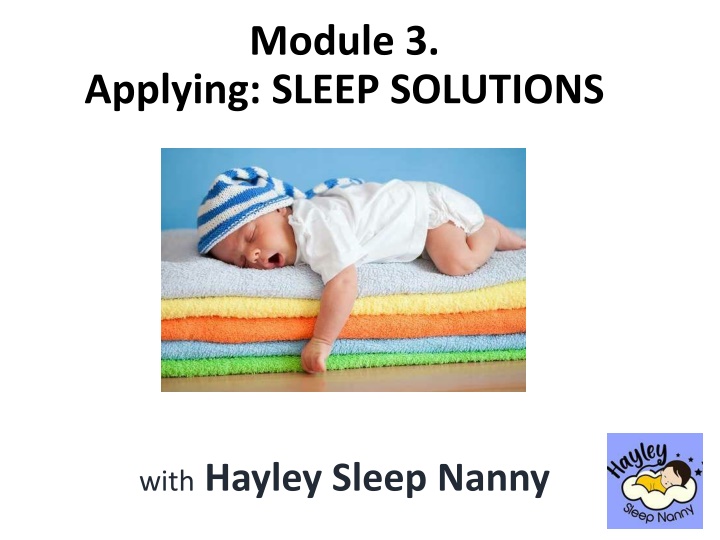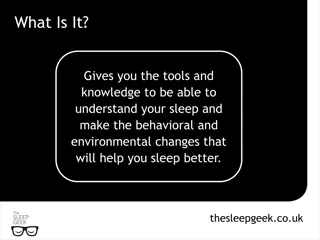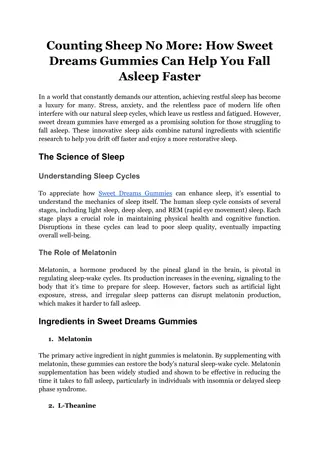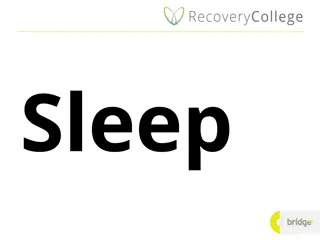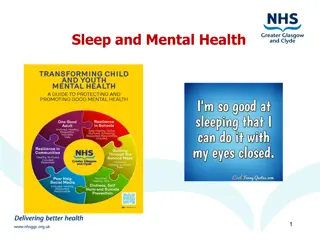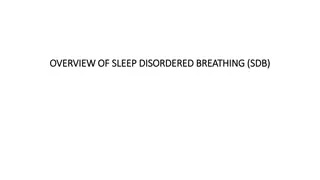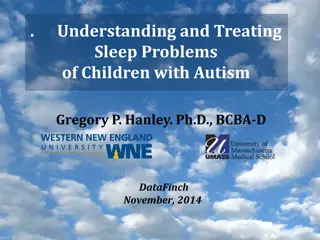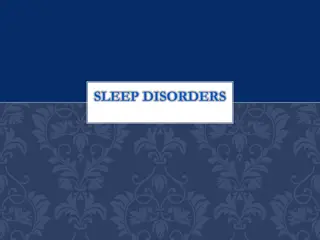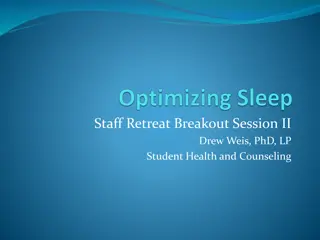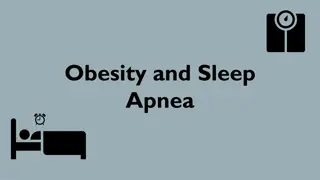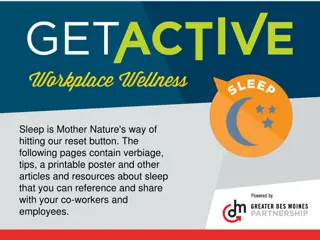Practical Sleep Strategies for Parents and Babies
Implementing effective sleep solutions is crucial for parents dealing with infants. Coping strategies include prioritizing well-being, avoiding screens, and positive thinking. Understanding the four categories of sleep training - Extinction, Controlled Crying, Fading, and Attachment Parenting - can guide parents towards creating healthy sleep habits. New baby sleep shaping tips highlight the importance of consistency and soothing techniques from birth. Building a solid sleep foundation ensures ongoing success with sleep routines.
Uploaded on Nov 12, 2024 | 1 Views
Download Presentation

Please find below an Image/Link to download the presentation.
The content on the website is provided AS IS for your information and personal use only. It may not be sold, licensed, or shared on other websites without obtaining consent from the author.If you encounter any issues during the download, it is possible that the publisher has removed the file from their server.
You are allowed to download the files provided on this website for personal or commercial use, subject to the condition that they are used lawfully. All files are the property of their respective owners.
The content on the website is provided AS IS for your information and personal use only. It may not be sold, licensed, or shared on other websites without obtaining consent from the author.
E N D
Presentation Transcript
Module 3. Applying: SLEEP SOLUTIONS with Hayley Sleep Nanny
Module 3 Content: Coping Strategies for parents 4 Categories for sleep solutions Approaches for all needs Building your sleep pillars (for ongoing future success with sleep).
Coping Strategies for Parents Sleep when baby sleeps is easier said than done but try to if you can, especially at bedtime Ask for help and accept help that is offered A parent needs to make their own well-being a high priority Drink plenty of water and try to get outside every day Avoid screens for an hour before bedtime Choose your thoughts! If you decide you will not get enough sleep and feel tired, your brain will hear you (and vice-versa)
4 Categories of Sleep Training 4 Categories of Sleep Training Extinction - Putting the child down and not returning. Allowing him to eventually fall asleep alone Controlled Crying - Giving the child space to practice settling but returning at intervals to reassure Fading - Gently weaning a child off the need to have a parent do it for them Attachment parenting - ignoring any need to teach the child to self settle and just doing whatever it takes to make crying stop
A few of the approaches I A few of the approaches I use use
New Baby Sleep Shaping Sleep training is unlikely to be effective under 18 weeks of age Sleep shaping can start from birth (practice little and often) Setting up consistent rhythms and cues and giving baby some exposure to the sleep habits and environments you want to establish Practice putting a baby down when he begins to get drowsy Let him be in his sleep space for a few minutes even if he is fussing Reassurance lets him know you are there and will always return Use soothing techniques such as patting, shhhing, stroking to encourage a baby back to sleep Wake and Sleep Can be done from day one Let your baby fall asleep in your arms but when you place her down, wake her slightly.
The Four Step Fade Out The Four Step Fade Out General principle but needs customising for each child. Concept is gradually weaning the need for parental help to fall asleep Highly responsive - parent stays with the child Subtle moves like building a muscle Leads to lasting results Must be consistent and keep moving forward Works well in a cot but can be modified for those in a bed
Regulated Responding Regulated Responding It is a form of controlled crying Tends to see quick results Better to use this if the parent is already okay leaving the room Works well for those who are super alert and too stimulated by having anyone in the room Not harmful so long as there is a response Don t try this unless you can see it through
In a bed under two and a half In a bed under two and a half years years Not yet cognitively ready to understand the concept of staying in bed. May stay put for many weeks before finding freedom Challenge may be that the child gets out of bed a lot or tries to sit on or follow the parent If staying, stay still, calm and quiet, pat mattress to signal what is expected and don t interact - We are trying to avoid rewarding the getting up and If not staying in the room, there will likely be a need for return to bed several times It may be necessary to gate the doorway
Building your sleep pillars (for ongoing future success with sleep). Knowing your child's temperament and triggers Being responsive not reactive around sleep If you fall off track due to sickness holidays or leaps brush yourself off and don t let it go past 3 days. Tailoring and allowing sleep to change with your child. All things I do as a sleep consultant. Contact me for further help or support www.hayleysleepnanny.com
Week 3 Week 3 s consolidation tasks: s consolidation tasks: Take part in our 1:1
Any burning questions Pop me a ticket? (Link to schedule 1:1 calls with me).
